Stok Kangri, at 6,153 m (20,187 ft), is the tallest mountain in the Zanskar Range of the Himalaya. I wasn’t nervous about the climb but I did have a couple of concerns. Firstly, while the literature that I consulted recommended seven days for the ascent, I had only been acclimating in Leh for five days and was left with just five more for the climb. I was a little concerned that I might not have been adequately acclimatized.
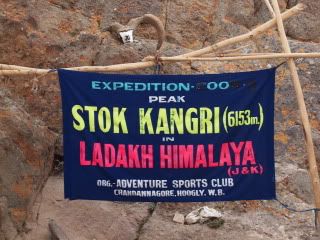
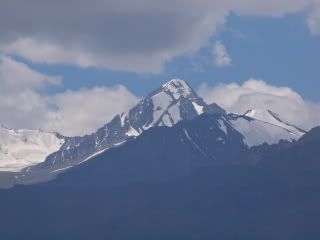
Three summers ago, at 18,000 ft. on Denali, I had a brush with severe altitude sickness. On day twenty-two of a thirty day expedition, stormed in at high camp, I began to fill Nalgenes with blood-streaked vomit. A helivac was impeded by the inclement weather and so, pumped full of dexamethasone, I was short-roped down the mountain in an indescribable thirty-two hour ordeal that involved the efforts of the national park service and innumerable faceless, but not forgotten, people who I will never be able to thank.
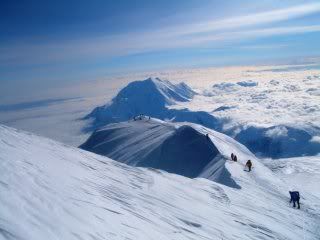
-------Denali-------
Altitude sickness can be unpredictable. It can impair a person at one time or on a certain climb and not at all on the next. For some reason, younger people are more susceptible to altitude sickness, but unfortunately not much is really known about it; there haven’t been many scientific studies done and I assume that there isn’t much money or motivation in finding a “cure.”
So, taking all of this and my past experiences into account, I was hoping for the best but was still a little uneasy.
---------------------------------
My guide was at my hotel at eight o’clock on Wednesday morning. I had met him the previous day but he had been quiet; he had sat there in the staging room with the solemnly reserved attention of a military man awaiting the orders of a superior officer.
“Tzetin, it’s good to meet you,” I had said, “but don’t call me ‘sir.’ My name is Ben.” Tzetin had been in the Indian Army for ten years and had lived in Ladakh for thirty-five. His parents had been Buddhists but he wasn’t. He worshiped the mountains but reluctantly agreed with Buddhist principles.
We packed a Tata pickup full of gear and drove to Stok Village, crossing the Indus River on a suspiciously rusty steel bridge along the way. In Stok we met Mutup the donkey driver. Two of the nine donkeys were babies, there not to carry loads but to learn the life of a pack animal. I think that donkeys’ nicknames belie their true character. They know what they want; after rubbing their too-large ears they would follow you around until I found a scrap of corrugated cardboard for them to snack on.

The trek meandered from the village up and into a rocky riverbed canyon. It soon began to rain, unusual for the region, and we stopped at one of the trailside yurts for a chai massala. The knock-off Northface shell that I had bought for six dollars in Leh had revealed itself as worthless in the downpour so Tzetin and I just waited in the dripping tent until it let up.
The rest of the way to Mankarmo only took us an hour and the entire day’s hike had been completed in two…half the time prescribed by the guidebook. We didn’t actually camp at Mankarmo but at a site six hundred meters down slope. An elderly man and woman live at the site during the summer months in a big white tent surrounded by donkey shit. The pair, I’m sure, does very well selling overpriced soup, tea, cigarettes, and poisonous spiced rum to foreigners. Tzetin and I crawled into the soggy tent and found seats on a dirt floor around the central support pole. The old man in a red robe emerged from a pile of blankets and switched on a cracked radio that he had fixed with strategically positioned rubber bands. The woman sat near us, stirring a pot of salt-tea on a kerosene stove. She smiled as Tzetin accepted a cup of the salt brew and cackled disapprovingly when I requested the exclusion of a wad of butter that dripped down her utensil index finger. Tzetin and the donkey driver talked for a while with the two mountain people before setting up camp. I asked Tzetin what it was the toothy woman had said that had so immediately drawn the attention of Mutup.
“He is worried about his baby donkeys. The woman says that she saw a snow leopard this morning on the ridge above campsite.”

I sat in the cook tent with the men and quickly understood why we had brought so many donkeys. I preparation Tzetin laid out a full pantry’s worth of spices, fresh vegetables, juice boxes, soup mixes, grains, lentils, and a bloody newspaper-wrapped sheep’s leg that had been severed just above the hip.
Supper was fantastic, begun with homemade french fries and tomato soup with parsley. We had Zuchini and cucumber mash followed by red dhal and rice with carrots and fresh ginger, fire roasted onions with garlic, and chili mutton in aubergine gravy. Just when I thought that the onslaught of food was finally over I was compelled to force down bananas and sliced pear for dessert. Alcohol and altitude do not mix well so I was a little unsettled when Tzetin produced a bottle of rum from one of the burlap donkey bags. The bottle looked nice. On closer inspection I was amused to see the warning on its label: “Possession by non defense personnel is a punishable crime.”
I quickly got over my reservations and took a few pegs in my cup of salt tea.
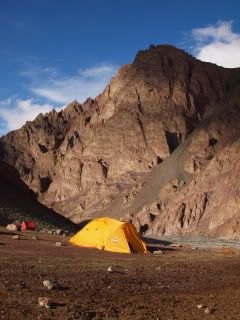

---------------------------------
I woke up to Mutup re-zipping my tent and rolled over to find a polished tin platter with a teapot and a plate of ornamentally arranged cookies on a doily napkin. The hike from Mankarmo to Basecamp took only two hours and was characterized by Tzetin and I rapidly overtaking groups that had left camp long before us. It’s always nice to travel in small groups; larger groups are slowed down by things that light travelers just don’t have to deal with.
The route was gorgeous, first following the same riverbed as the previous day and then rising out of the canyon into an alpine tundra littered with scampering marmots and lichen covered boulders. Basecamp was a small, tent city populated by roughly fifty people, thirty horses, nine donkeys, and a dozen wandering dzo – a mild mannered, bushy tailed cross between a yak and a Himalayan cow. The site was incredible but its aesthetic beauty was tarnished by an obscene amount of trash that not even the garbage disposal dzos could keep up with, though they did give an alarming but ultimately unsuccessful effort to ingest discarded soda bottles. Now, as a NOLS (www.nols.edu) boy, I am particularly sensitive to violators of Leave No Trace principles and so in this case, the trashing of the campsite was disturbing. Every time I saw some smiling idiot duck behind a rock with a roll of toilet paper instead of using the pre-dug latrine, I felt like going vigilante with my ice axe.
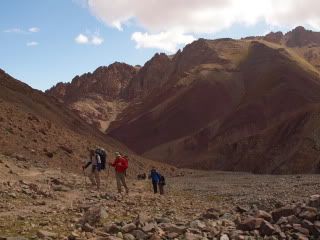
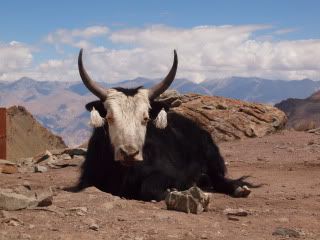
Dinner, again, was great. More mutton, chow mien with broccoli and chilies, steamed cauliflower, ginger saffron tea, anchovies in tomato sauce, and creamed chicken soup.
At midnight I stumbled into the cook tent where Tzetin was warming some porridge. Most people spend a day acclimating at Basecamp, and move to High Camp the following day, before finally making the push to the summit. However, Tzetin and I had been feeling good, and the mountain gods had given us a window of perfect weather that we couldn’t resist, so we decided to just go for it from Basecamp. Even if we had to turn around, we figured that we would have two more days to either try again or move to High Camp and take it from there.
I was a little dismayed by how cold it was; much more so than I had expected. A dozen headlamps speckled the ridge high above camp. I wondered if we were starting too late but Tzetin and I caught up and passed the other parties within an hour of leaving camp. The first ridge was tough. I was cold, breathing heavily, and sucking dust that was being kicked up by Tzetin in front of me. We were moving very fast and when we reached the other hikers in High Camp at the edge of the glacial moraine we decided to stop and have some hot tea. Tzetin poured me a cup from his thermos and we were both surprised that it had already gone cold. I schwilled my water bottle but choked on the tinkling shards of ice that were beginning to form. Looking around the star-lit moonscape at the other people perched on their backpacks I thought to myself that they too must have been silently questioning their motivations. At 18,000 ft, at a time of night when sane people are comfortably asleep in their beds, you begin to wonder why you are not. Maybe you are insane…maybe you are an addict…or maybe you’re just a little weird. My suspicions were confirmed when a group of four announced that they were turning back. The others in their party seemed disappointed but at the moment were to self-occupied to voice much of an opposition. The other climbers, in their plastic mountaineering boots, down, fleece, polypropylene, and insulated stretchy tech-wear, seemed content to sit there for as long as their guides would allow. I, on the other hand, was too cold to rest. My toes were freezing through one layer of thin wool socks and it took kicking my New Balance jogging sneakers against boulders to return feeling to them. After a summer in Rajasthan my cold weather clothing was pretty limited but I had found a few, warm, wool-stuffs in Leh. Under my blue jeans I wore a pair of thick wool Indian Army long underwear. I had on a thin wool T-shirt, a thick yak-wool sweater, and a kashmir/rayon pullover hoodie. My yak-wool mittens were thin an ineffective, but my knit hat and silk paisley scarf saved me.
The glacier crossing didn’t take more than half an hour. It wasn’t much of a glacier; completely incomparable to those of Alaska or Washington that take hours, sometimes days, to cross. Even so, I disagreed with the route that Tzetin had chosen. I suggested an alternative to which he agreed more out of appeasement than concern for safety. My route took longer but ran perpendicular rather than parallel to the beckoning crevasses.
By then there were no climbers ahead of us and as we climbed the headwall I would turn every now and then to see the slower groups snaking their way through the moraine, each one of them a triangular beam of fluorescent glow and shadow on a colorless wall. My favorite thing about glaciers has always been their animate characteristics. These massive forces of nature appear static and lifeless, but they are not. From ice worms that burrow at night and wiggle to the glistening surface at dawn, to the steam train rushes of wind that howl through deeper blue-ice crevasses: glaciers are alive and will show you if you pay attention.
Nearing the black silhouette of the saddled summit ridge I stared stupidly at the brilliant night sky. With comparatively little atmosphere between us, the starscape was absolutely spectacular and I tripped often, looking at frequent shooting stars instead of at my feet. Every so often the muffled gunshot sound of the cracking, groaning glacier would interrupt our silenced heavy breathing.
We had reached the summit ridge at 4:45 and by then it was bitterly cold. Thankfully though, the eastern sky began to glow and the promise of warming sun reenergized us both. The ridge was steep and the drop on the frozen western side gaping. I was tired but by no means exhausted. The high altitude meant that we were taking three deep breaths between every paused step, but for me the thin air was not as big of an issue as what I call “electric hands.” At 20,000 ft. your body’s circulatory system begins to protest and the sudden rush of blood into inert limbs can be surprisingly painful. I have had the same issue on other climbs, and especially on Mt. McKinley, but never before as severe as on Stok Kangri. As the ridge became steeper and I was forced to use my hands for scrambling stability, each reach or outstretch sent a startling electric shock radiating from my fingertips to my neck. I tried to use my hands as little as possible, tried stuffing them in the pits of my sweater, but I decided that electrified hands were more acceptable than tumbling down the sheer western face.
The final hundred meters of the climb were silly. Tzetin and I wanted to be on the summit to see the sun rising over the eastward range and so we would scramble too quickly for thirty seconds before stopping to wheeze, laugh, and lean on our ice axes for a few minutes before doing it all again.
We sat on the summit and sucked on frozen apricots as the sun ignited the Indus Valley 10,000 ft. below. The valley and mountains to the west were eclipsed by the massive triangular shadow cast by Stok Kangri and to the north, in the far distance, were the 7,000-meter massifs of the Karakorum.
---------------------------------
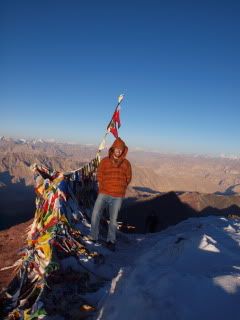
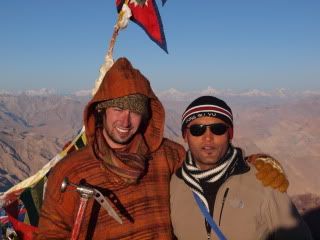
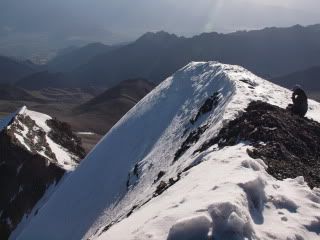
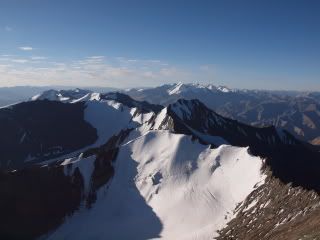
---------------------------------
About an hour had passed before the first of the other parties arrived on the summit. An Austrian woman took a few photos of me and Tzetin posing next to a frozen mass of wind-sculpted prayer flags before, shouldering our bags, we began down the ridge. The headwall was steep and chocked with crumbling, shifting rocks and I was glad to be able to use my axe as a walking stick.
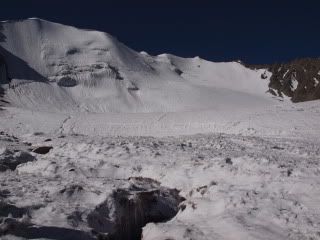
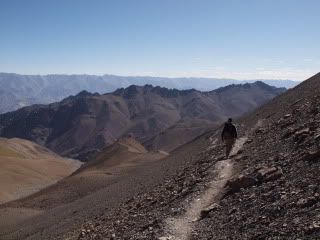
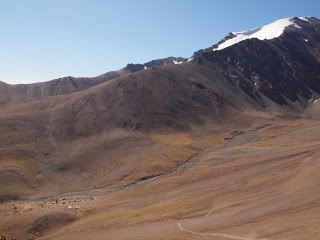
Basecamp is in the bottom-left corner
It had taken us only four and a half hours to summit and, after an hour spent on top and two hours downclimbing, the two of us loped into Basecamp at 9:00am. Another guide, a friend of Tzetin, stepped into our cook tent, blinking, surprised to see us back so soon.
“What happened?” he asked us, assuming that we had turned back below the summit.
“Nahee,” said Tzetin. “It was too cold and we couldn’t go slowly.”
“That must be some sort of record,” the other guide said before leaning in to give us both high-fives.
Tzetin and Muttup would have been content doing what most groups do after summiting. that is, spend the day resting in Basecamp and hiking the fifteen kilometers back to Stok village the following morning. But I had a lingering altitude headache and didn’t want to pay for an extra day of needless guiding and donkey portering. So, after endless grumbling from Muttup, who had been expecting five days’ pay rather than three, we packed up camp and began the stumble-step trek back through the high meadows, riverbed canyons, and rocky alpine passes.
---------------------------------
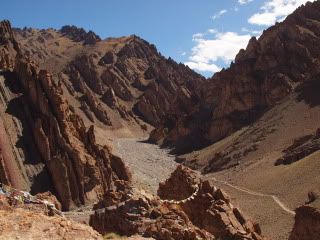
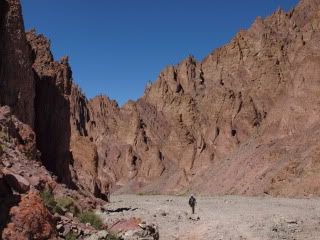
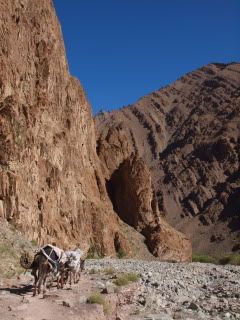


---------------------------------
Later, that evening as I sat on the rooftop of my hotel with a full beer and a full stomach, across the valley the engorged sun dipped behind the summit ridge of Stok Kangri and, as the stars slowly revealed themselves to me for the second time that day, I thought to myself for the umpteenth time that day, “hell yeah...this is it.”